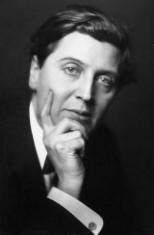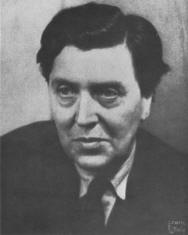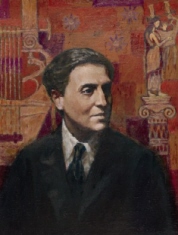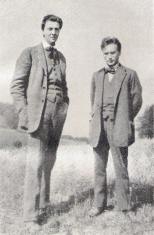|
|
Alban Berg (Composer) |
|
Born: February 9, 1885 - Vienna, Austria
Died: December 24, 1935 - Vienna, Austria |
|
Alban Maria Johannes Berg was an Austrian composer. He was a member of the Second Viennese School with Arnold Schoenberg and Anton Webern, and produced compositions that combined Mahlerian Romanticism with a personal adaptation of A. Schoenberg's twelve-tone technique. |
|
Life and work |
|
Alban Berg was born in Vienna, the third of four children of Johanna and Conrad Berg. His family lived comfortably until the death of his father in 1900. He was more interested in literature than music as a child and did not begin to compose until he was fifteen, when he started to teach himself music. In late February or early March of 1902 he fathered a child with Marie Scheuchl, a servant girl in the Berg family household. His daughter, Albine, was born on December 4, 1902.
Alban Berg had little formal music education before he became a student of Arnold Schoenberg in October 1904. With A. Schoenberg he studied counterpoint, music theory, and harmony. By 1906, he was studying music full-time; by 1907, he began composition lessons. His student compositions included five drafts for piano sonatas. He also wrote songs, including his Seven Early Songs (Sieben Frühe Lieder), three of which were Berg's first publicly performed work in a concert that featured the music of A. Schoenberg's pupils in Vienna that year. The early sonata sketches eventually culminated in Berg's Piano Sonata (Op. 1) (1907-1908); it is one of the most formidable "first" works ever written (Lauder, 1986). Berg studied with A. Schoenberg for six years until 1911. Berg admired him as a composer and mentor, and they remained close lifelong friends. Berg may have seen the older composer as a father figure, as Berg's father had died when he was only 15.
Among A. Schoenberg's teaching was the idea that the unity of a musical composition depends upon all its aspects being derived from a single basic idea; this idea was later known as developing variation. Berg passed this on to his students, one of whom, Theodor Adorno, stated: "The main principle he conveyed was that of variation: everything was supposed to develop out of something else and yet be intrinsically different". The Piano Sonata is an example - the whole composition is derived from the work's opening quartal gesture and its opening phrase.
Alban Berg was a part of Vienna's cultural elite during the heady fin de siècle period. His circle included the musicians Alexander von Zemlinsky and Franz Schreker, the painter Gustav Klimt, the writer and satirist Karl Kraus, the architect Adolf Loos, and the poet Peter Altenberg. In 1906, Berg met the singer Helene Nahowski, daughter of a wealthy family (said by some to be in fact the illegitimate daughter of Emperor Franz Joseph I of Austria from his liaison with Anna Nahowski); despite the outward hostility of her family, the two were married on May 3, 1911. In 1913, two of Berg's Five Songs on Picture Postcard Texts by Peter Altenberg (1912) were premièred in Vienna, conducted by A. Schoenberg. Settings of aphoristic utterances, the songs are accompanied by a very large orchestra. The performance caused a riot, and had to be halted; the work was not performed in full until 1952 (and its full score remained unpublished until 1966).
From 1915 to 1918, Alban Berg served in the Austrian Army and during a period of leave in 1917 he began work on his first opera, Wozzeck. After the end of World War I, he settled again in Vienna where he taught private pupils. He also helped A. Schoenberg run his Society for Private Musical Performances, which sought to create the ideal environment for the exploration and appreciation of unfamiliar new music by means of open rehearsals, repeat performances, and the exclusion of professional critics.
Three excerpts from Wozzeck were performed in 1924, and this brought Berg his first public success. The opera, which Berg completed in 1922, was not performed in its entirety until December 14, 1925, when Erich Kleiber directed a performance in Berlin. Today Wozzeck is seen as one of Berg's most important works. Berg completed only the first two acts of his later opera, the critically acclaimed Lulu, before he died.
Berg's best-known piece is his elegiac Violin Concerto. Like much of his mature work, it employs a personal adaptation of A. Schoenberg's twelve tone technique that enables the composer to combine frank atonality with passages that use more traditional tonal harmonies; additionally, Berg incorporates quotations from historical tonal music, including a Bach chorale and a Carinthian folk song. The Violin Concerto was dedicated to Manon, the deceased daughter of architect Walter Gropius and Alma Schindler. Other well known Berg compositions include the Lyric Suite (seemingly a significant influence on the String Quartet No. 3 of Béla Bartók), Three Pieces for Orchestra and the Chamber Concerto for violin, piano and 13 wind instruments.
Berg died in Vienna, on Christmas Eve 1935, apparently from blood poisoning caused by an insect bite. He was 50 years old.
Douglas Jarman writes in the New Grove: "As the 20th century closed, the 'backward-looking' Berg suddenly came as Perle remarked, to look like its most forward-looking composer." |
|
Major compositions |
|
Piano:
Piano Sonata, Op.1
Kammerkonzert (1925) for piano, violin and 13 wind instruments
Chamber:
String Quartet, Op. 3
Four Pieces for Clarinet and Piano, Op. 5
Lyric Suite
Orchestra:
Three Pieces for Orchestra, Op. 6
Violin Concerto
Opera:
Wozzeck, Op. 7
Lulu
Vocal:
Seven Early Songs
Four Songs, Op. 2
Five Orchestral Songs on Postcard Texts of Peter Altenberg, Op. 4
Der Wein
Schliesse mir die Augen beide |
|










|
|
Sources:
Wikipedia Website [from Douglas Jarman: "Alban Berg", Grove Music Online, ed. L. Macy (Accessed April 9, 2007)
The Oxford Dictionary of Opera, by John Warrack and Ewan West (1992)]
Contributed by Aryeh Oron (May 2008) |
|
Use of Chorale Melodies in his works |
|
Violin Concerto ("To the memory of an angel", no opus number) (1935, Berg’s last composition) based upon 4 tone rows, a Carinthian [from Kärnten, Austria] folksong and the chorale melody Es ist genug. In the final Adagio mvt. Berg included two variations based upon the Bach chorale setting Es ist genug, Herr, so nimm denn meinen Geist. The chorale, which appears near the end of the Concerto in fulfilment of its programme as a Requiem, is foreshadowed from the beginning, its opening notes embedded in the work's 12-note series.
(CM: Es ist genug; 1935) |
|
Links to other Sites |
|
Alban Berg (Wikipedia)
Alban Berg (Classical Music Pages)
Alban Berg: Resources for All
Alban Berg (Karadar)
Alban Berg (W.W. Norton)
Alban Berg (Decca)
Alban Berg Biography (Naxos)
Alban Berg (1885 - 1935) (Find A Grave Memorial)
Alban Berg (Britannica Online Encyclopedia)
Classical Music Archives: Biography of Alban Berg
Alban Berg (Infoplease) |
|
Bibliography |
|
Analytical writings :
Theodor W. Adorno: Alban Berg: Master of the Smallest Link, translated by Juliane Brand & Christopher Hailey. (New York: Cambridge University Press, 1991)
Janet Schmalfeldt: "Berg’s Path to Atonality: The Piano Sonata, Op. 1". Alban Berg: Historical and Analytical Perspectives. Eds. David Gable and Robert P. Morgan, pgg. 79-110 (New York: Oxford University Press, 1991)
Robert Neil Lauder: Two Early Piano Works of Alban Berg: A Stylistic and Structural Analysis. Thesis (Chapel Hill: University of North Carolina, 1986)
Siglind Bruhn, ed.: Encrypted Messages in Alban Berg’s Music (New York: Garland Publishing, 1998)
Kraus Schweizer: Die Sonatensatzform im Schaffen Alban Bergs (Stuttgart: Satz und Druck, 1970)
Jay Weldon Wilkey: Certain Aspects of Form in the Vocal Music of Alban Berg. Ph.D. thesis (Ann Arbor: Indiana University, 1965)
George Perle: The operas of Alban Berg (Berkeley: University of California Press, 1980)
Douglas Jarman: Schon's Five-Strophe Aria: Some Notes on Tonality and Pitch Association in Berg's Lulu (Perspectives of New Music 8/2, Spring/Summer 1970)
Douglas Jarman: Some Rhythmic and Metric Techniques in Alban Berg's Lulu (Musical Quarterly 56/3, July 1970)
Douglas Jarman: Lulu: The Sketches (International Alban Berg Society Newsletter, 6, June 1978)
Douglas Jarman: The Music of Alban Berg (Berkeley: University of California Press, 1979)
Douglas Jarman: Countess Geschwitz's Series: A Controversy Resolved? (Proceedings of the Royal Musical Association 107, 1980/81)
Douglas Jarman: Some Observations on Rhythm, Meter and Tempo in Lulu. In Alban Berg Studien. Ed. Rudolf Klein (Vienna: Universal Edition, 1981)
Douglas Jarman: Lulu: The Musical and Dramatic Structure (Royal Opera House Covent Garden program notes, 1981)
Douglas Jarman: The 'Lost' Score of the 'Symphonic Pieces from Lulu' (International Alban Berg Society Newsletter 12, Fall/Winter 1982)
Biographical writings:
Juliane Brand, Christopher Hailey & Donald Harris, eds.: The Berg-Schoenberg Correspondence: Selected Letters (New York: Norton, 1987)
Bernard Grun, ed.: Alban Berg: Letters to his Wife (London: Faber and Faber, 1971)
Contantin Floros, translated by Ernest Bernhardt-Kabisch: Alban Berg and Hanna Fuchs (Bloomington: Indiana University Press, 2007)
H.F. Redlich: Alban Berg, the Man and His Music (London: John Calder, 1957)
Willi Reich: The life and work of Alban Berg, translated by Cornelius Cardew (New York : Da Capo Press, 1982)
Karen Monson: Alban Berg: a biography (London: Macdonald and Jane's, 1979)
Mosco Carner: Alban Berg: the man and the work (London: Duckworth, 1975)
Hans Ferdinand Redlich: Alban Berg, the man and his music (London: J. Calder, 1957)
René Leibowitz: Schoenberg and his school; the contemporary stage of the language of music, translated by Dika Newlin (New York: Philosophical Library, 1949) |
|
|